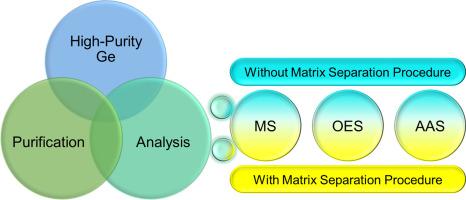Talanta ( IF 5.6 ) Pub Date : 2022-08-05 , DOI: 10.1016/j.talanta.2022.123792 Tatiana Ya Guselnikova 1

|
This article is devoted to a review of studies on the determination of trace elements in germanium and germanium dioxide. For this purpose, methods both with and without preliminary matrix separation procedure have been developed and applied. The advantage of methods without a matrix separation procedure is simple and fast sample preparation, since it does not require specific devices or installations. On the other hand, the limits of detection (LODs) of trace elements remain relatively high, and the germanium matrix effect occurs when attempts are made to lower them. Since germanium and germanium dioxide are currently among the purest substances, the purest germanium containing trace elements at the level of pg g−1 are used for producing nuclear radiation detectors. Therefore, to achieve low LODs for trace elements, a matrix separation procedure is conducted. Another positive point is that preliminary germanium separation leads to a decrease in the matrix effect. In the article the matrix separation procedure performed by various methods is considered. These procedures can be classified into open, closed or flow kinds, depending on the type of installation. Germanium is usually separated in the form of tetrahalide, most commonly, tetrachloride. For the determination of trace elements in germanium and germanium dioxide, single element methods (atomic absorption spectrometry) and multielement methods (atomic emission spectrometry, mass-spectrometry, neutron activation analysis) are used. In this article, these methods are compared in terms of the number of elements determined and the LODs.
中文翻译:

锗基功能材料元素分析的历史与最新进展
本文专门对锗和二氧化锗中微量元素测定的研究进行综述。为此目的,已经开发和应用了具有和不具有初步基质分离程序的方法。没有基质分离程序的方法的优点是简单和快速的样品制备,因为它不需要特定的设备或安装。另一方面,微量元素的检出限 (LOD) 仍然相对较高,当试图降低检出限时会出现锗基质效应。由于锗和二氧化锗是目前最纯净的物质之一,因此最纯净的锗含有pg g -1水平的微量元素用于生产核辐射探测器。因此,为了实现微量元素的低 LOD,需要进行基质分离程序。另一个积极的方面是初步锗分离导致基质效应降低。在本文中,考虑了通过各种方法执行的基质分离过程。根据安装类型,这些程序可分为开放式、封闭式或流动式。锗通常以四卤化物的形式分离,最常见的是四氯化物。锗和二氧化锗中微量元素的测定采用单元素法(原子吸收光谱法)和多元素法(原子发射光谱法、质谱法、中子活化分析法)。在本文中,











































 京公网安备 11010802027423号
京公网安备 11010802027423号